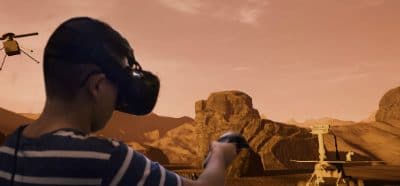A group of researchers at NAU are currently working in a collaborative effort to propose new ways to explore the surface of Mars. For over 30 years Mars has been extensively mapped and explored by space probes and and planetary rovers. They have yielded enormous amounts of data but often scientists have not been able to interpret much of this data.
Current rover science is limited to a semi-autonomous probe with on-board instruments
to sample and send back data to earth. NAU researchers in the astrophysics group and Interactive + Immersive Virtual Reality Lab (IVR), would like to propose new methodologies for doing Mars research. With the addition of drones and immersive media, they believe they can discover new ways to do science on the surface of Mars.
Dr. Mark Salvatore, a martian geologist at NAU, says that drones and VR technology could “give us a greater sense of scale, depth perception, and relativity, all of which will save time.” Using multi-band laser scanners, the surface of a terrain can be scanned by a drone, and a 3D reconstruction of the terrain created to explore it in VR. This could allow researchers to do virtual geology on the surface of another planet and do better remote science. Scientists could essentially explore the surface of another planet alongside the robotic explorer.
“Utilizing multispectral data, we can detect differences in plant moisture and soil moisture,” says Dr. Temuulen “Teki” Sankey, a drone expert and LIDAR researcher at NAU. “Rovers are currently very limited, in terms of how much of an area they can see… we have no idea what goes on outside of the rover’s pathway. The drone can scan those areas, without having a rover drive around all over the place,” she says. NASA is very interested in UAV technology to expand the capabilities of robotic missions and has plans to use drones on Mars. Indeed, combining UAVs and Virtual Reality may lead to new methods for exploring the surface of Mars that could change the way scientists think of tele-robotic exploration.
Working with drone experts, geologists, and astrophysicists, the virtual reality lab at NAU is expanding its research across the campus. The ten interns in the IVR lab this semester all contribute to the research projects currently underway. NAU’s unique academic environment stands to put young students into the process of creating new research methods for one of the most prestigious scientific organizations in the world. Interns for the IVR lab are comprised of Computer Science, Interior and Architecture, Business, Visual Communication, Film and Media and Strategic Communication students.
The IVR Lab is working with researchers across the NAU community to expand the research opportunities for NAU researchers. Current pending grants include the Archeology reference resource grant, National Endowment for the Humanities ($380k), Informal Learning, National Science Foundation grant ($1.9 million), a Hearst Foundation grant for $400k, and the NASA PSTAR grant ( $ 2 million). The IVR lab hopes to be able to expand its research activities to support the University’s goal of becoming a top tier Research University.
